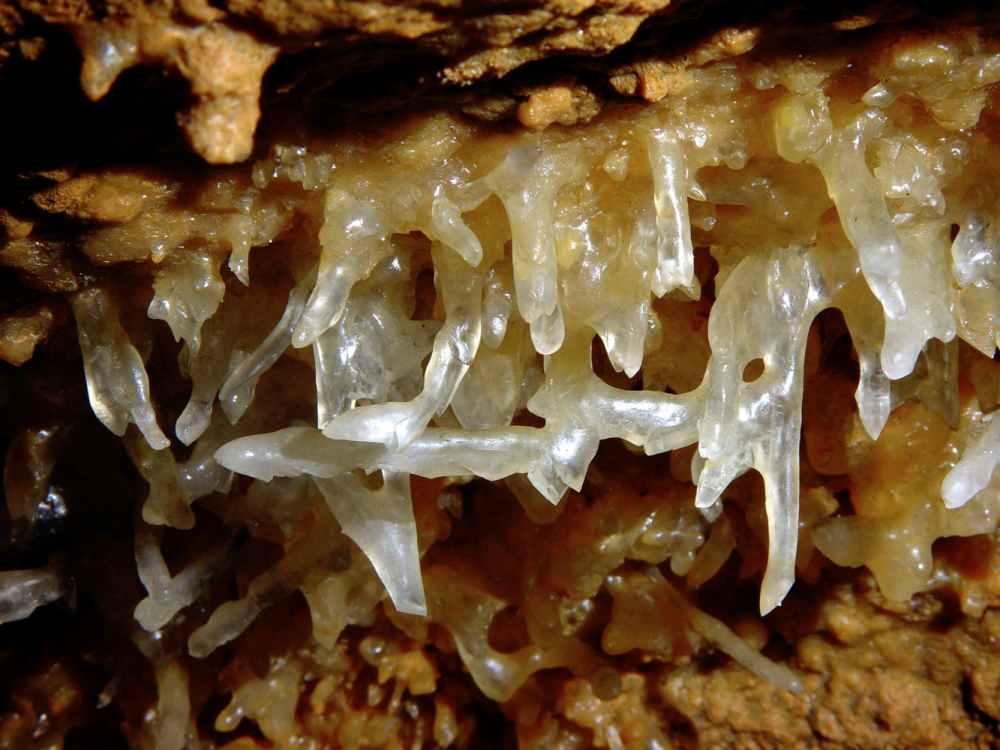Koněprusy (Koněpruské) Caves - Natural conditions

Geological development of the area
The Bohemian Karst consists of parental rocks of the Silurian and Devonian Periods, which form the core of the Prague region's older Palaeozoic basin – the central part of the geological unit called the Barrandien. From the lower Silurian until the middle Devonian, marine carbonates (limestone) settled here, followed by clays and sands for a short time until the sea completely retreated as a result of the mountain-forming events of the Variscan (Hercynian) orogeny. During the upper Devonian to lower Carboniferous Periods, the Variscan orogeny broke up the whole region, folding it to form a mountain chain and turning the bulk of what is today the Czech Republic into dry land for a very long time. This changed in the late Mesozoic Era (the upper Cretaceous period) when it was flooded by seas once again.
Evidence of the formation of karst cavities comes from as early as the Jurassic Period, just before the formation of the Cretaceous sea. After this sea too retreated, the process of limestone dissolution and the emergence of karst continued more intensely in the Tertiary, significantly facilitated by vertical movements in the area caused by Alpine folding in the neighbourhood and the associated revival of erosion and the development of river networks. For underground cavities to emerge, tectonic faults and fissures along N–S to NNW–SSE axes had considerable importance.
As evidenced by the earliest palaeontological findings from the surroundings of the Koněprusy Caves, underground spaces existed in this area and were occupied by living creatures as early as the middle Tertiary. Afterwards, the development of the cave levels were bound to the gradual deepening of the river network and the formation of river terraces in the late Tertiary and in the early Quaternary Period – the Pleistocene epoch.
The entire territory of the Barrandien, including the Bohemian Karst, is a major world geological unit. Early Palaeozoic deposits and extraordinary amounts of fossils contained therein were examined and presented to the public beginning in 1852 by French researcher Joachim Barrande. It is also this segment that harbours well-stratified early Palaeozoic deposits, a model for global geology and known as 'international stratotypes', as well as sites of the first-ever fossils referred to as holotypes.
Geological discoveries were also facilitated through the intense process of extraction of limestone rocks in countless quarries, reduced to this day into just a few large-scale industrial operations.
In 1868, the quarry on the Golden Horse hill also became a source of one of the foundation stones for the National Theatre in Prague. The foyer of the theatre presents the same quarry on a painting by Vincent Beneš.
Decoration of the Koněprusy Caves
The relatively long and complicated development of the Koněprusy Caves is also reflected in their secondary mineral and sinter fills that form the caves' decorations. These are formed through the elimination of the mineral content from karst solutions. In the Koněprusy Caves' decorations, calcite is the predominant mineral; it yields various types of dripstone formations in the area. There are sinter 'waterfalls' of rather large dimensions and thicknesses hanging down from high chimneys. Some of the area has a cover of floor sinters with stalagmites and, occasionally, even dykes and small sinter lakes in which one can also find the remains of underground pearls.
Other minerals found locally include aragonite, gypsum, members of the apatite group, quartz, opal, and, according to some reports, chalcedony.
The Koněprusy Caves include all of the five generations of cave decorations found in the Bohemian Karst. Of these, the oldest generation is particularly notable: it consists of white different types of crystal aggregates in a variety of structures as well as corallites with formations called Koněprusy rosettes. The presence of opal – considerable in some places – makes these rosettes unique to this location. Opal can be found across various generations of the decoration and almost throughout the height span of the cave; the source of silica is primarily the chemical weathering of the covering formations during the fading tropical/subtropical climate. Immediately prior to the formation of this generation of decoration, black manganese deposits settled in the cave. The next generation of decorations consists of tubular or even coarsely crystalline sinters called 'honey sinters' due to their colour. One of the largest stalagmites in the Czech Republic towers inside the Prošek Dome: 7 metres tall, its foot diameter is 10 metres and is formed by 3 layers of sinters in its top portion. Decorations formed by the youngest generations of sinters are quite common.
Multi-generation gypsum crusts and crystals appear on the walls of the caves in some places; these mineral deposits are probably produced locally by the weathering of pyrite in the Suchomasty limestone. It is often accompanied by opal or, rarely, aragonite. In many places of the middle floor we also find apatite coatings, likely resulting from the reaction of bat guano with limestone. A great rarity involves limestone cavities up to several centimetres in size completely filled with small crystals of quartz.